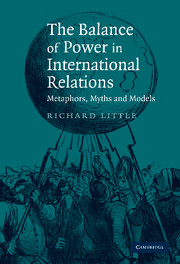Book contents
- Frontmatter
- Contents
- List of figures
- Acknowledgements
- Part I Introduction
- Part II Metaphors, myths and models
- Part III Balance of power models
- 4 Hans J. Morgenthau's Politics Among Nations
- 5 Hedley Bull's The Anarchical Society
- 6 Kenneth N. Waltz's Theory of International Politics
- 7 John J. Mearsheimer's The Tragedy of Great Power Politics
- Part IV Conclusion
- Bibliography
- Index
6 - Kenneth N. Waltz's Theory of International Politics
Published online by Cambridge University Press: 05 October 2014
- Frontmatter
- Contents
- List of figures
- Acknowledgements
- Part I Introduction
- Part II Metaphors, myths and models
- Part III Balance of power models
- 4 Hans J. Morgenthau's Politics Among Nations
- 5 Hedley Bull's The Anarchical Society
- 6 Kenneth N. Waltz's Theory of International Politics
- 7 John J. Mearsheimer's The Tragedy of Great Power Politics
- Part IV Conclusion
- Bibliography
- Index
Summary
Waltz (1979: 117) insists that if there is any ‘distinctively political theory of international politics, balance of power is it’ and in Theory of International Politics he attempts to formulate and clarify the basis for such a theory. He recognizes, of course, that there is no agreed statement of the theory, and that even the meaning of the balance of power is the source of endless disagreement. As a consequence, he ponders whether it is not ‘quixotic’ to attempt to cut through the confusion that surrounds the idea. Nevertheless, this is the aim that he sets himself and in attempting to establish a model of the balance of power he produced one of the most widely cited and controversial books in the field. Although, on the face of it, much of the book is not directly concerned with the balance of power, its entire contents are designed, in practice, to establish what constitute the necessary conditions for a successful theory of international politics and to explain why the balance of power provides the most effective candidate for developing such a theory.
The main aim of this chapter is to explicate the essential features of Waltz's model of the balance of power, but in the process, two incidental but significant insights that run directly counter to conventional assessments of Theory of International Politics also and somewhat unexpectedly emerge.
- Type
- Chapter
- Information
- The Balance of Power in International RelationsMetaphors, Myths and Models, pp. 167 - 212Publisher: Cambridge University PressPrint publication year: 2007
- 2
- Cited by



